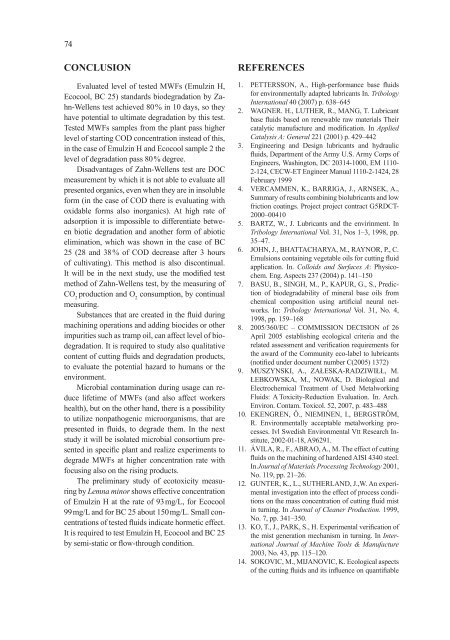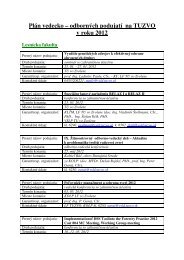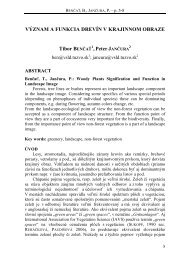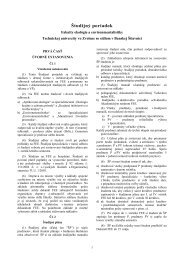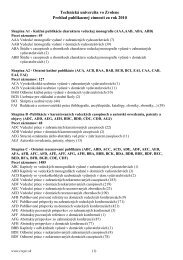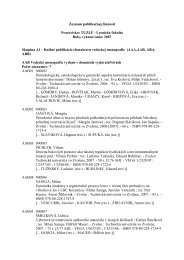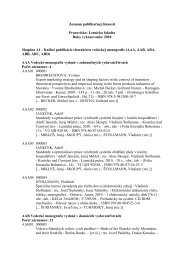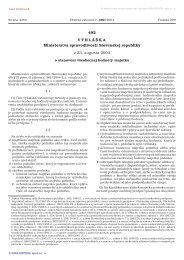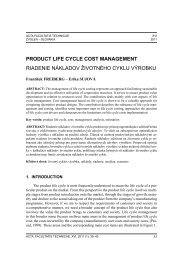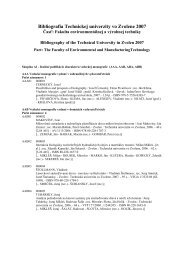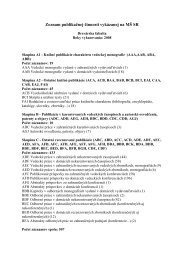73Fig. 4 Treated (after 28 days of cultivating) and non–treated MWFs standards and samples.BC 25 – standard before, BC 25´ standard after, E – Ecocool standard before, E´– Ecocool standard after,EH – Emulzin H standard before, EH´– Emulzin H standard after,1 – Emulzin H sample before, 1´– Emulzin H after, 3 – BC 25 sample before, 3´– BC 25 sample after, 5 – Ecocoolsample 1 befere, 5´– Ecocool sample 1 after, 7 – Ecocool sample 2 before, 7´– Ecocool sample 2 after.Ecotoxicity evaluation Riadkovanie 1,5Preliminary study of selected MWFs ecotoxicityon Lemna minor is shown in the Fig. 5a-c.For the test to be valid, the doubling time of frondnumber in the control must be less than 2,5 days(60 h), corresponding to approximately a seven–fold increase in seven days and an average specificgrowth rate of 0,275 d –1 . Average specific growthrate were evaluated for all tests in the range 0,23–0,24 d –1 and pass the criteria for the test.In the concentration of 0,001 mg/L; 0,01 mg/L;and 0,1 mg/L of all tested cutting fluid were obser-ved hormesis – stimulatory effect on growth. Effectiveconcentration of tested MWFs that effect50 % of growth inhibition was evaluated from thearea under the growth curves and for Emulzin Hwas about 93 mg/L, for Ecocool 99 mg/L. BC 25has affect lesser inhibition in compare to the others– about 150 mg/L.The test was realized in the static conditionbut it shows to be advantageous to study effect onLemna minor in semi-static or semi-static and flow--through condition with renewal of testing solutiondue to observed little precipitation during the test.inhibition [%] n=3908070605040302010average value04,5 4,75 5 5,25 5,5log cinhibition [%] n=38070605040302010average value4,5 4,75 5 5,25 5,5log cinhbition [%] n=39080706050403020100average value4,75 5,25 5,75log cFig. 5a EC 50evaluation of Emulzin H Fig. 5b EC evaluation of Ecocool Fig. 5c EC evaluation of BC 2550 50with Lemna minor with Lemna minor with Lemna minor
74CONCLUSIONEvaluated level of tested MWFs (Emulzin H,Ecocool, BC 25) standards biodegradation by Zahn-Wellenstest achieved 80 % in 10 days, so theyhave potential to ultimate degradation by this test.Tested MWFs samples from the plant pass higherlevel of starting COD concentration instead of this,in the case of Emulzin H and Ecocool sample 2 thelevel of degradation pass 80 % degree.Disadvantages of Zahn-Wellens test are DOCmeasurement by which it is not able to evaluate allpresented organics, even when they are in insolubleform (in the case of COD there is evaluating withoxidable forms also inorganics). At high rate ofadsorption it is impossible to differentiate betweenbiotic degradation and another form of abioticelimination, which was shown in the case of BC25 (28 and 38 % of COD decrease after 3 hoursof cultivating). This method is also discontinual.It will be in the next study, use the modified testmethod of Zahn-Wellens test, by the measuring ofCO 2production and O 2consumption, by continualmeasuring.Substances that are created in the fluid duringmachining operations and adding biocides or otherimpurities such as tramp oil, can affect level of biodegradation.It is required to study also qualitativecontent of cutting fluids and degradation products,to evaluate the potential hazard to humans or theenvironment.Microbial contamination during usage can reducelifetime of MWFs (and also affect workershealth), but on the other hand, there is a possibilityto utilize nonpathogenic microorganisms, that arepresented in fluids, to degrade them. In the nextstudy it will be isolated microbial consortium presentedin specific plant and realize experiments todegrade MWFs at higher concentration rate withfocusing also on the rising products.The preliminary study of ecotoxicity measuringby Lemna minor shows effective concentrationof Emulzin H at the rate of 93 mg/L, for Ecocool99 mg/L and for BC 25 about 150 mg/L. Small concentrationsof tested fluids indicate hormetic effect.It is required to test Emulzin H, Ecocool and BC 25by semi-static or flow-through condition.REFERENCES1. PETTERSSON, A., High-performance base fluidsfor environmentally adapted lubricants In. TribologyInternational 40 (2007) p. 638–6452. WAGNER. H., LUTHER, R., MANG, T. Lubricantbase fluids based on renewable raw materials Theircatalytic manufacture and modification. In AppliedCatalysis A: General 221 (2001) p. 429–4423. Engineering and Design lubricants and hydraulicfluids, Department of the Army U.S. Army Corps ofEngineers, Washington, DC 20314-1000, EM 1110-2-124, CECW-ET Engineer Manual 1110-2-1424, 28February 19994. VERCAMMEN, K., BARRIGA, J., ARNSEK, A.,Summary of results combining biolubricants and lowfriction coatings. Project project contract G5RDCT-2000–004105. BARTZ, W., J. Lubricants and the envirinment. InTribology International Vol. 31, Nos 1–3, 1998, pp.35–47.6. JOHN, J., BHATTACHARYA, M., RAYNOR, P., C.Emulsions containing vegetable oils for cutting fluidapplication. In. Colloids and Surfaces A: Physicochem.Eng. Aspects 237 (2004) p. 141–1507. BASU, B., SINGH, M., P., KAPUR, G., S., Predictionof biodegradability of mineral base oils fromchemical composition using artificial neural networks.In: Tribology International Vol. 31, No. 4,1998, pp. 159–1688. 2005/360/EC – COMMISSION DECISION of 26April 2005 establishing ecological criteria and therelated assessment and verification requirements forthe award of the Community eco-label to lubricants(notified under document number C(2005) 1372)9. MUSZYNSKI, A., ZAŁESKA-RADZIWIŁŁ, M.ŁEBKOWSKA, M., NOWAK, D. Biological andElectrochemical Treatment of Used MetalworkingFluids: A Toxicity-Reduction Evaluation. In. Arch.Environ. Contam. Toxicol. 52, 2007, p. 483–48810. EKENGREN, Ö., NIEMINEN, I., BERGSTRÖM,R. Environmentally acceptable metalworking processes.Ivl Swedish Environmental Vtt Research Institute,2002-01-18, A96291.11. ÁVILA, R., F., ABRAO, A., M. The effect of cuttingfluids on the machining of hardened AISI 4340 steel.In Journal of Materials Processing Technology 2001,No. 119, pp. 21–26.12. GUNTER, K., L., SUTHERLAND, J.,W. An experimentalinvestigation into the effect of process conditionson the mass concentration of cutting fluid mistin turning. In Journal of Cleaner Production. 1999,No. 7, pp. 341–350.13. KO, T., J., PARK, S., H. Experimental verification ofthe mist generation mechanism in turning. In InternationalJournal of Machine Tools & Manufacture2003, No. 43, pp. 115–120.14. SOKOVIC, M., MIJANOVIC, K. Ecological aspectsof the cutting fluids and its influence on quantifiable
- Page 2 and 3:
Acta FacultatisEcologiaeJournal of
- Page 4 and 5:
OBSAH / CONTENTSISOL M., MICHALÍKO
- Page 6:
5ACTA FACULTATIS ECOLOGIAE, 16: Sup
- Page 12:
11ACTA FACULTATIS ECOLOGIAE, 16: Su
- Page 18 and 19:
17ACTA FACULTATIS ECOLOGIAE, 16: Su
- Page 20 and 21:
19are lower in ill patients compare
- Page 22:
21are considered as the most accura
- Page 25 and 26: 24- multimode cavities are usually
- Page 27 and 28: 26the load during its exposure to f
- Page 29 and 30: 28Tradescantia paludosa 02 test and
- Page 31 and 32: 30Tab. 5: Results of positive contr
- Page 34 and 35: 33ACTA FACULTATIS ECOLOGIAE, 16: Su
- Page 36 and 37: 35DISCUSSIONThe ionising radiation
- Page 38 and 39: 37ACTA FACULTATIS ECOLOGIAE, 16: Su
- Page 40 and 41: 39222Rn is produced by radioactive
- Page 42 and 43: 41180160140this reason we also pick
- Page 44: 435001450400350hKz0,8h [m]300250200
- Page 47 and 48: 46deposit is that stripped in off-l
- Page 49 and 50: 48TruenessTrueness was determined i
- Page 51 and 52: 50MATERIAL AND METHODSChloroform (p
- Page 53 and 54: 52absorbance [a.u.]1,000,750,500,25
- Page 55 and 56: 54Tab. 1: Rrequirements determinati
- Page 57 and 58: 56Methods of VOC testing were set a
- Page 60 and 61: 59Tab. 6: ContinuedSamples withsurf
- Page 62 and 63: 61ACTA FACULTATIS ECOLOGIAE, 16: Su
- Page 64 and 65: 63One of the possible explanations
- Page 66 and 67: 65Ai - Ai-1 [Bq.m -3 ]86420-2-4-6-8
- Page 68 and 69: 67ACTA FACULTATIS ECOLOGIAE, 15: Su
- Page 70 and 71: 69BiodegradabilityThe great variety
- Page 72 and 73: 71degradation starts of late days,
- Page 76: 75parameters of the cutting process
- Page 80 and 81: 79Fraction: D (residual rest) prese
- Page 82: 81was not confirmed. Maximum of mer
- Page 85 and 86: 84Fig. 1 Schematic diagram of atomi
- Page 87 and 88: 86Alpha spectrometryAlpha spectrome
- Page 89 and 90: 8880007000y = 6622xR 2 = 0.939SIMS
- Page 92 and 93: 91ACTA FACULTATIS ECOLOGIAE, 16: Su
- Page 94 and 95: 93Gemer according to the German mod
- Page 96 and 97: 95Tab. 1 Results of the chemical an
- Page 98 and 99: 97Continuation of Tab. 2 Results of
- Page 100 and 101: 99Vlčia Dolina and from the reserv
- Page 102 and 103: 101ACTA FACULTATIS ECOLOGIAE, 16: S
- Page 104 and 105: 103mg.dm -3mg.dm -35,004,003,002,00
- Page 106 and 107: 105year and the average value repre
- Page 108 and 109: 107ACTA FACULTATIS ECOLOGIAE, 16: S
- Page 110 and 111: 109Sample site 1 Sample site 2 Samp
- Page 112 and 113: 111As for the sampling time (Fig. 5
- Page 114 and 115: 113ACTA FACULTATIS ECOLOGIAE, 16: S
- Page 116 and 117: 115Typha latifolia, Carex sp., Scir
- Page 118 and 119: 117conditions for decomposition of
- Page 120 and 121: 119ACTA FACULTATIS ECOLOGIAE, 16: S
- Page 122 and 123: 121from the background (derived fro
- Page 124 and 125:
12311. PETROVSKÝ, E., ELWOOD, B.:
- Page 126 and 127:
125ACTA FACULTATIS ECOLOGIAE, 16: S
- Page 128 and 129:
1272.52.0Correlation coefficient 0,
- Page 130 and 131:
129ACTA FACULTATIS ECOLOGIAE, 16: S
- Page 132 and 133:
131RESULTS AND DISCUSSIONTable 2 gi
- Page 134 and 135:
133ACTA FACULTATIS ECOLOGIAE, 16: S
- Page 136 and 137:
135V-1 BOREHOLEThe courses of 222 R
- Page 138 and 139:
137AV-2 (40m) 2006A ( 222 Rn) [kBq/
- Page 140 and 141:
139soaks into the soil, another par
- Page 142 and 143:
141ACTA FACULTATIS ECOLOGIAE, 16: S
- Page 144 and 145:
143Fig. 2 The continuous monitoring
- Page 146 and 147:
145Indoor radon activity concentrat
- Page 148 and 149:
147ACTA FACULTATIS ECOLOGIAE, 16: S
- Page 150 and 151:
149Fig. 1 Podlipa dump-fieldCanada)
- Page 152 and 153:
151concentrations of Fe. Cu. Cd. Ni
- Page 154 and 155:
153DUMP-FIELDREFERENCE SITEppm15001
- Page 156 and 157:
155Fig. 5 Compression of wood forma
- Page 158 and 159:
157decrease in the following order:
- Page 160 and 161:
159ACTA FACULTATIS ECOLOGIAE, 16: S
- Page 162 and 163:
161SPECIFIC EXAMPLES OFFACTORS THAT
- Page 164 and 165:
163ACTA FACULTATIS ECOLOGIAE, 16: S
- Page 166 and 167:
165The methods developed to incorpo
- Page 168 and 169:
167The effects of wind on ozone con
- Page 170 and 171:
169Fig. 6 Mean total and stomatal f
- Page 172 and 173:
171transport modelling in North Ame
- Page 175:
Acta Facultatis Ecologiae, Volume 1


